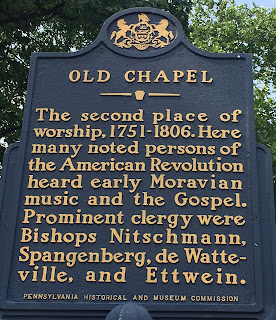As of this writing, Moravian Bethlehem is still on the U.S. Tentative List to become a UNESCO World Heritage Site. If you're not familiar with the term, these are locations around the world which have been recognized by the United Nations Educational, Scientific, and Cultural Organization (UNESCO). They have been determined to be unique landmarks with distinctive geographic and historical identities, which have cultural significance "of outstanding value to humanity." Right now, Pennsylvania only has two UNESCO World Heritage Sites to its name - Independence Hall in Philadelphia and Fallingwater, Frank Lloyd Wright's masterpiece outside of Pittsburgh - so if the Moravian Community is selected for the honor, it will become our third. It's a process that takes years; they've been working toward this since 2002. You can keep tabs on the whole thing here - it's very exciting! I have every intention of being there for whatever celebration they decide to have for the occasion.
Well, with all the explorations I've been doing of other counties, I realized that I haven't done a Moravian Bethlehem blog post all year. So I'd say we're way overdue. This one is a little more picture-heavy than some of my posts, because I just couldn't bring myself to stop at three like I usually do.
I've written a fair few things about the Moravians already, so I don't want to repeat myself too much for the longtime readers. For a brief recap, I'll quote from my post about the First House of Bethlehem:
Moravians the world over trace the origins of their faith to 15th century Europe. It started in 1457, when Jan Hus and his followers formed the Unitas Fratum (Unity of the Brethren) in Kunvald, in what is now the Czech Republic. Although the movement was driven underground, it eventually resurfaced in 1722 thanks to Count Nikolaus Ludwig von Zinzendorf. He allowed a contingent of Protestant refugees from Moravia (also in the Czech Republic) to move onto his estate in what is now eastern Germany, where they set up a village called Herrnhut. Under the good count's leadership, the Unity of the Brethren was revived and the settlement attracted people from all over Europe. Since the original settlers were from Moravia, the followers of this religious movement came to be called Moravians.
 |
| The marker is situated on Heckewelder Place near the intersection with Church Street |
The marker cites it as the second place of worship. The first place of worship was the second building constructed in the community, known as the Gemeinhaus (clergy house), which has its own marker. In 1751 the chapel was completed. Of course they didn't call it the Old Chapel at that time; it was just the chapel. The music-loving Moravians would gather there for worship services, led by prominent members of the community. Bishop Nitschmann, whose name is mentioned on the marker, has a school named after him in the Bethlehem Area School District.
 |
| This old image was acquired courtesy of Lehigh Valley History on Facebook |
I couldn't enter the chapel on the day that I took all these photographs, unfortunately. At least, I didn't have any reason to think I could; I didn't actually try the door. But luck was still on my side a little bit, because there was a tour of the Moravian Community in progress and the tour guide didn't seem to mind my tagging along at the end of the group. So I was able to walk around the entire chapel, as well as getting pictures of the other nearby buildings. Below is the photo I took of the chapel from the western side; the doorway on the far right leads to a sort of pass-through, where the timber pictured above can be seen. I heartily recommend getting in on such a tour if you manage to get to Bethlehem, because the docents know their stuff and the area is beautiful.
Moravian Walking Tour and Guide Book, published by the Moravian Historical Society, 2014
Zug, Jeanette Barres. The Old Moravian Chapel: A Guided Tour. Oaks Printing Co., Nazareth PA, 1989.
Old Chapel at the Historical Marker Database
Except where indicated, all writing and photography on this blog is the intellectual property of Laura Klotz. This blog is written with permission of the Pennsylvania Historical and Museum Commission. I am not employed by the PHMC. All rights reserved.




No comments:
Post a Comment
I would love to hear from you!